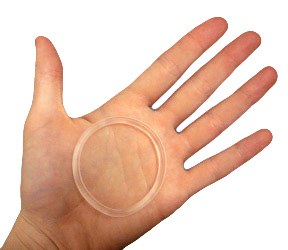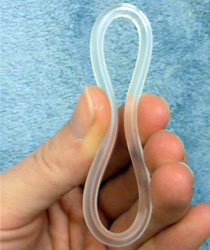
Microbicides for sexually transmitted infections are pharmacologic agents and chemical substances that are capable of killing or destroying certain microorganisms that commonly cause sexually transmitted infection.

Personal lubricants are specialized lubricants used during sexual acts, such as intercourse and masturbation, to reduce friction to or between the penis and vagina, anus or other body parts or applied to sex toys to reduce friction or to ease penetration. As of 2015, the personal lubricant market was estimated to be worth at least $400 million.

Vaginal rings are polymeric drug delivery devices designed to provide controlled release of drugs for intravaginal administration over extended periods of time. The ring is inserted into the vagina and provides contraception protection. Vaginal rings come in one size that fits most women.

A contraceptive vaginal ring is a type of hormonal insert that is placed in the vagina for the purpose of birth control. The rings themselves utilize a plastic polymer matrix that is inlaid or embedded with contraceptive drug. This drug, often one or two hormones, is absorbed directly through the bloodstream through the cells that line the vaginal wall. Some vaginal rings contain both an estrogen and a progestin, which are available in Europe and the United States. Other vaginal rings contain just progesterone. The progesterone-only ring is only available in Latin America, exclusively for postpartum breastfeeding parents.

Pre-exposure prophylaxis for HIV prevention, commonly known as PrEP, is a form of medication used to prevent HIV infection, the cause of HIV/AIDS.
The International Partnership for Microbicides or IPM is a non-profit product development partnership (PDP) founded by Dr. Zeda Rosenberg in 2002 to prevent HIV transmission by accelerating the development and availability of a safe and effective microbicide for use by women in developing countries.
CAPRISA 004 is the name of a clinical trial conducted by CAPRISA. This particular study was the first to show that a topical gel could reduce a person's risk of contracting HIV. The gel used in the study contained a microbicide.
Zeda Fran Rosenberg is an American microbiologist and epidemiologist, active in HIV biology and prevention. She is the chief executive officer of the International Partnership for Microbicides (IPM). IPM was founded by Rosenberg in 2002 and is a nonprofit organization dedicated to developing microbicides and other innovative HIV prevention products and making them available for women in developing countries.

CONRAD is a non-profit scientific research organization that works to improve global and reproductive health, particularly in women in developing countries. CONRAD was established in 1986 under a cooperative agreement between Eastern Virginia Medical School (EVMS) and the United States Agency for International Development (USAID). CONRAD’s products are developed primarily for women in low-resource settings, in that they are designed to be safe, affordable and user-friendly. CONRAD is led by Scientific and Executive Director Gustavo F. Doncel, M.D., Ph.D. Primary funding for CONRAD comes from the U.S. President's Emergency Plan for AIDS Relief (PEPFAR) through the U.S. Agency for International Development (USAID), with additional funding from The Bill & Melinda Gates Foundation and the National Institutes of Health (NIH).
A rectal microbicide is a microbicide for rectal use. Most commonly such a product would be a topical gel inserted into the anus so that it make act as protection against the contract of a sexually transmitted infection during anal sex.
PRO 2000 is an experimental vaginal microbicide which has been proposed as a preventive medicine for reducing the risk of contracting HIV. It has never been recommended as an effective medicine to be used for any purpose. Some clinical trials have shown that under some conditions it may provide some protection against HIV.
A vaginal microbicide is a microbicide for vaginal use, generally as protection against the contraction of a sexually transmitted infection during vaginal sexual intercourse. Vaginal microbicides are topical gels or creams inserted into the vagina.
The Microbicide Trials Network was a United States government-funded research organization working in the field of microbicides for sexually transmitted diseases. The MTN focused on research into microbicides which would prevent HIV infection. The MTN was a member of HANC. After its closure, partner organization HIV Prevention Trials Network took control of its projects.

HIV/AIDS research includes all medical research that attempts to prevent, treat, or cure HIV/AIDS, as well as fundamental research about the nature of HIV as an infectious agent and AIDS as the disease caused by HIV.

Elioda Tumwesigye is a Ugandan politician, physician, and epidemiologist who has served as minister of science, technology and innovation in the cabinet of Uganda since June 2016. From March 2015 until June 2016, he served as the minister of health.

Dapivirine is a non-nucleoside reverse transcriptase inhibitor developed at Janssen Therapeutics. The International Partnership for Microbicides has held exclusive worldwide rights to dapivirine since 2014, building upon a 2004 royalty-free license to develop dapivirine-based microbicides for women in resource-poor countries.
Multipurpose prevention technologies (MPTs) are a class of products designed to address at least two health issues simultaneously, often focusing on sexual and reproductive health which includes contraception, human immunodeficiency virus (HIV) prevention, other sexually transmitted infection (STI) preventions, such as genital infection by human simplex virus (HSV) infection and human papillomavirus (HPV) infection. For example, MPTs can combine contraception and HIV prevention, contraception and other STI prevention, or the prevention of multiple STIs. Since the simultaneous use of multiple products with a single indication against each specific sexual and reproductive health issue is inconvenient, this method may affect adherence. As a result, the goal of developing a MPT as an all-in-one product is to combat this issue.
Elizabeth Anne Bukusi FAAS is a research professor working within the field of obstetrics and gynaecology, and global health. Bukusi's main areas of research focus around sexually transmitted infections, women's health, reproductive health, and HIV care, prevention and treatment. Bukusi is the Chief Research Officer at the Kenya Medical Research Institute (KEMRI) and led a "landmark" study on the use of PrEP in Kenya.
Sharon Louise Hillier is an American microbiologist. She is the Richard Sweet Endowed Chair in Reproductive Infectious Disease and vice chair of the department of obstetrics, gynecology and reproductive sciences at the University of Pittsburgh Medical Center (UPMC) and Magee-Women's Research Institute.

Jeanne Marisa Marrazzo is an American physician-scientist and infectious diseases specialist. She was the director of the University of Alabama School of Medicine Division of Infectious Diseases and focused on prevention of HIV infection using biomedical interventions. Marrazzo is a fellow of the American College of Physicians and Infectious Disease Society of America. On August 2, 2023 Lawrence A. Tabak, acting director for the National Institutes of Health (NIH), named Jeanne M. Marrazzo as director of NIH’s National Institute of Allergy and Infectious Diseases.















